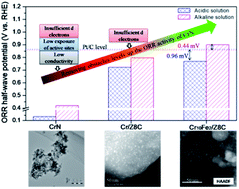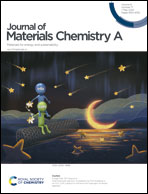A strategy to unlock the potential of CrN as a highly active oxygen reduction reaction catalyst†
Abstract
Developing cheap and highly active oxygen reduction reaction (ORR) electrocatalysts is of great importance for fuel cells and Zn–air batteries. Transition-metal nitrides are theoretically promising ORR catalysts, but their actual ORR performance is disappointing. Insufficient d electrons, low exposure of active sites and low conductivity are the three obstacles preventing transition-metal nitrides from being competitive ORR catalysts. Herein, we introduce a comprehensive solution that manages to remove all these obstacles and improve the ORR activity of transition-metal nitrides to the level of leading non-noble metal ORR catalysts. We first prepared a Cr/Z8C material by dispersing ZIF-8 derived carbon in an ethanol solution of CrCl3 followed by a nitridation process. Using the ZIF-8-derived carbon as a support, we managed to acquire very small CrN nanoparticles, overcoming their aggregation and enhancing their conductivity. By further doping with Fe or Co, we enriched the d electrons of CrN and enhanced its adsorption to oxygen. The Fe-doped Cr/Z8C material exhibited extraordinary ORR activity. Its ORR half-wave potential in alkaline media was 44 mV higher than that of the commercial Pt/C catalyst, and its ORR half-wave potential in acidic media was only 96 mV lower than that of the commercial Pt/C catalyst. This work demonstrates the great potential of transition-metal nitrides as ORR catalysts and opens up a new road to exploit cheap and highly active ORR catalysts.



 Please wait while we load your content...
Please wait while we load your content...